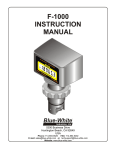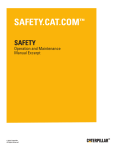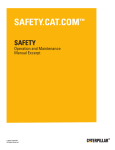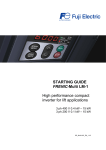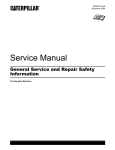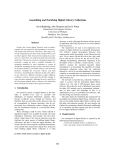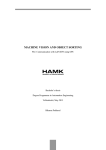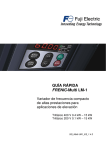Download 950F Series II Wheel Loader - Safety
Transcript
SAFETY Operation and Maintenance Manual Excerpt © 2010 Caterpillar All Rights Reserved ® ® SEBU6492-04 May 2002 Operation and Maintenance Manual 950F Series II Wheel Loader 4DJ1-Up (Machine) 5SK1-Up (Machine) 8TK1-Up (Machine) 2LM1-Up (Machine) i01658146 Important Safety Information Most accidents that involve product operation, maintenance and repair are caused by failure to observe basic safety rules or precautions. An accident can often be avoided by recognizing potentially hazardous situations before an accident occurs. A person must be alert to potential hazards. This person should also have the necessary training, skills and tools to perform these functions properly. Improper operation, lubrication, maintenance or repair of this product can be dangerous and could result in injury or death. Do not operate or perform any lubrication, maintenance or repair on this product, until you have read and understood the operation, lubrication, maintenance and repair information. Safety precautions and warnings are provided in this manual and on the product. If these hazard warnings are not heeded, bodily injury or death could occur to you or to other persons. The hazards are identified by the “Safety Alert Symbol” and followed by a “Signal Word” such as “DANGER”, “WARNING” or “CAUTION”. The Safety Alert “WARNING” label is shown below. The meaning of this safety alert symbol is as follows: Attention! Become Alert! Your Safety is Involved. The message that appears under the warning explains the hazard and can be either written or pictorially presented. Operations that may cause product damage are identified by “NOTICE” labels on the product and in this publication. Caterpillar cannot anticipate every possible circumstance that might involve a potential hazard. The warnings in this publication and on the product are, therefore, not all inclusive. If a tool, procedure, work method or operating technique that is not specifically recommended by Caterpillar is used, you must satisfy yourself that it is safe for you and for others. You should also ensure that the product will not be damaged or be made unsafe by the operation, lubrication, maintenance or repair procedures that you choose. The information, specifications, and illustrations in this publication are on the basis of information that was available at the time that the publication was written. The specifications, torques, pressures, measurements, adjustments, illustrations, and other items can change at any time. These changes can affect the service that is given to the product. Obtain the complete and most current information before you start any job. Caterpillar dealers have the most current information available. When replacement parts are required for this product Caterpillar recommends using Caterpillar replacement parts or parts with equivalent specifications including, but not limited to, physical dimensions, type, strength and material. Failure to heed this warning can lead to premature failures, product damage, personal injury or death. 6 Safety Section Safety Signs and Labels Do Not Operate Safety Section i01379017 Safety Signs and Labels SMCS Code: 7000 There are several specific safety signs on this machine. The exact location of the hazards and the description of the hazards are reviewed in this section. Please become familiarized with all safety signs. Make sure that all of the safety signs are legible. Clean the safety signs or replace the safety signs if you cannot read the words. Replace the illustrations if the illustrations are not legible. When you clean the safety signs, use a cloth, water and soap. Do not use solvent, gasoline, or other harsh chemicals to clean the safety signs. Solvents, gasoline, or harsh chemicals could loosen the adhesive that secures the safety sign. Loose adhesive will allow the safety sign to fall. Replace any safety sign that is damaged or missing. If a safety sign is attached to a part that is replaced, install a safety sign on the replacement part. Any Caterpillar dealer can provide new safety signs. Illustration 2 g00728128 This warning label is positioned in the cab. DO NOT OPERATE OR WORK ON THIS MACHINE UNLESS YOU HAVE READ AND UNDERSTAND THE INSTRUCTIONS AND WARNINGS IN THE OPERATION AND MAINTENANCE MANUALS. FAILURE TO FOLLOW THE INSTRUCTIONS OR HEED THE WARNINGS COULD RESULT IN INJURY OR DEATH. CONTACT ANY CATERPILLAR DEALER FOR REPLACEMENT MANUALS. PROPER CARE IS YOUR RESPONSIBILITY. 7 Safety Section Safety Signs and Labels ROPS Illustration 3 No Clearance g00728156 Illustration 4 g00728534 This warning label is positioned on the outside of the cab on the left side. This warning label is positioned on each side of the machine at the center pivot. Structural damage, an overturn, modification, alteration, or improper repair can impair this structure’s protection capability thereby voiding this certification. Do not weld on or drill holes in the structure. Consult a Caterpillar dealer to determine this structure’s limitations without voiding its certification. No clearance for person in this area when machine turns. Severe injury or death from crushing could occur. “Rollover (ROPS) and Falling Object (FOPS) Protective Structure Certification ” “Disconnect lock and secure before resuming operation.” “This structure, when properly installed on a machine which is not altered to exceed the certification test mass meets, at the time of installation, criteria established by: SAE J394, SAE J1040 APR88, ISO 3471-1:1986, ISO 3471:1994, SAE J231 JAN 81, ISO 3449:1992 LEVEL II.” “Connect steering frame lock between front and rear frames before lifting, transporting, or servicing machine in articulation area.” 8 Safety Section Safety Signs and Labels High Pressure Cylinder Illustration 5 Compressed Spring g00728545 This warning label is positioned at the center pivot on the left side of the machine. Illustration 6 g00728555 HIGH PRESSURE CYLINDER Do not remove any valve, hydraulic fitting, or valve core, nor disassemble any parts until pressure has been relieved or personal injury may occur. To relieve pressure: 1. Shut off engine and wait five minutes for hydraulic system pressure to dissipate. 2. Relieve gas pressure in the accumulator cylinder by opening the charging valve one turn only. Charge cylinder with dry nitrogen gas. Precharge pressure _______ PSI _______kPa. Service pressure (Operating-Loaded) ______PSI ______kPa. Minimum bursting pressure _____PSI _____kPa. See your Caterpillar dealer for tools and detailed information required for charging cylinders. This warning label is located on the parking brake actuator. Do not attempt to remove spring(s), they are not serviceable. Do not cut, saw, torch or modify this chamber, serious injury or death may result. 9 Safety Section General Hazard Information Improper Jumper Cable Connection Know the width of your equipment in order to maintain proper clearance when you operate the equipment near fences or near boundary obstacles. Be aware of high voltage power lines and power cables that are buried. If the machine comes in contact with these hazards, serious injury or death may occur from electrocution. Illustration 7 g00728596 Open the access panel on the left side of the machine. The warning is positioned on the inside of the battery compartment. Illustration 9 Improper jumper cable connections can cause explosion resulting in personal injury. Batteries may be located in separate compartments, always connect positive (+) cable to positive (+) terminal of battery connected to starter solenoid and negative (−) cable from external source to engine block or frame. i01426767 General Hazard Information SMCS Code: 7000 g00702020 Wear a hard hat, protective glasses, and other protective equipment, as required. Do not wear loose clothing or jewelry that can snag on controls or on other parts of the equipment. Make sure that all protective guards and all covers are secured in place on the equipment. Keep the equipment free from foreign material. Remove debris, oil, tools, and other items from the deck, from walkways, and from steps. Secure all loose items such as lunch boxes, tools, and other items that are not a part of the equipment. Know the appropriate work site hand signals and the personnel that are authorized to give the hand signals. Accept hand signals from one person only. Do not smoke when you service an air conditioner. Also, do not smoke if refrigerant gas may be present. Inhaling the fumes that are released from a flame that contacts air conditioner refrigerant can cause bodily harm or death. Inhaling gas from air conditioner refrigerant through a lighted cigarette can cause bodily harm or death. Illustration 8 g00104545 Attach a “Do Not Operate” warning tag or a similar warning tag to the start switch or to the controls before you service the equipment or before you repair the equipment. These warning tags (Special Instruction, SEHS7332) are available from your Caterpillar dealer. Never put maintenance fluids into glass containers. Drain all liquids into a suitable container. Obey all local regulations for the disposal of liquids. Use all cleaning solutions with care. Report all necessary repairs. 10 Safety Section General Hazard Information Do not allow unauthorized personnel on the equipment. Unless you are instructed otherwise, perform maintenance with the equipment in the servicing position. Refer to Operation and Maintenance Manual for the procedure for placing the equipment in the servicing position. Pressure Air and Water Pressurized air and/or water can cause debris and/or hot water to be blown out. This could result in personal injury. When pressure air and/or pressure water is used for cleaning, wear protective clothing, protective shoes, and eye protection. Eye protection includes goggles or a protective face shield. Illustration 10 g00687600 The maximum air pressure for cleaning purposes must be below 205 kPa (30 psi). The maximum water pressure for cleaning purposes must be below 275 kPa (40 psi). Always use a board or cardboard when you check for a leak. Leaking fluid that is under pressure can penetrate body tissue. Fluid penetration can cause serious injury and possible death. A pin hole leak can cause severe injury. If fluid is injected into your skin, you must get treatment immediately. Seek treatment from a doctor that is familiar with this type of injury. Trapped Pressure Containing Fluid Spillage Pressure can be trapped in a hydraulic system. Releasing trapped pressure can cause sudden machine movement or attachment movement. Use caution if you disconnect hydraulic lines or fittings. High pressure oil that is released can cause a hose to whip. High pressure oil that is released can cause oil to spray. Fluid penetration can cause serious injury and possible death. Care must be taken in order to ensure that fluids are contained during performance of inspection, maintenance, testing, adjusting and repair of the equipment. Prepare to collect the fluid with suitable containers before opening any compartment or disassembling any component containing fluids. Fluid Penetration Pressure can be trapped in the hydraulic circuit long after the engine has been stopped. The pressure can cause hydraulic fluid or items such as pipe plugs to escape rapidly if the pressure is not relieved correctly. Do not remove any hydraulic components or parts until pressure has been relieved or personal injury may occur. Do not disassemble any hydraulic components or parts until pressure has been relieved or personal injury may occur. Refer to the Service Manual for any procedures that are required to relieve the hydraulic pressure. Refer to Special Publication, NENG2500, “Tools and Shop Products Guide” for the following items: • Tools that are suitable for collecting fluids and equipment that is suitable for collecting fluids • Tools that are suitable for containing fluids and equipment that is suitable for containing fluids Obey all local regulations for the disposal of liquids. 11 Safety Section Crushing Prevention and Cutting Prevention Asbestos Information • Comply with applicable rules and regulations for the work place. In the United States, use Occupational Safety and Health Administration (OSHA) requirements. These OSHA requirements can be found in “29 CFR 1910.1001”. • Obey environmental regulations for the disposal of asbestos. • Stay away from areas that might have asbestos particles in the air. Dispose of Waste Properly Illustration 11 g00702022 Caterpillar equipment and replacement parts that are shipped from Caterpillar are asbestos free. Caterpillar recommends the use of only genuine Caterpillar replacement parts. Use the following guidelines when you handle any replacement parts that contain asbestos or when you handle asbestos debris. Use caution. Avoid inhaling dust that might be generated when you handle components that contain asbestos fibers. Inhaling this dust can be hazardous to your health. The components that may contain asbestos fibers are brake pads, brake bands, lining material, clutch plates, and some gaskets. The asbestos that is used in these components is usually bound in a resin or sealed in some way. Normal handling is not hazardous unless airborne dust that contains asbestos is generated. If dust that may contain asbestos is present, there are several guidelines that should be followed: • Never use compressed air for cleaning. • Avoid brushing materials that contain asbestos. • Avoid grinding materials that contain asbestos. • Use a wet method in order to clean up asbestos materials. • A vacuum cleaner that is equipped with a high efficiency particulate air filter (HEPA) can also be used. • Use exhaust ventilation on permanent machining jobs. • Wear an approved respirator if there is no other way to control the dust. Illustration 12 g00706404 Improperly disposing of waste can threaten the environment. Potentially harmful fluids should be disposed of according to local regulations. Always use leakproof containers when you drain fluids. Do not pour waste onto the ground, down a drain, or into any source of water. i01359664 Crushing Prevention and Cutting Prevention SMCS Code: 7000 Support the equipment properly before you perform any work or maintenance beneath that equipment. Do not depend on the hydraulic cylinders to hold up the equipment. Equipment can fall if a control is moved, or if a hydraulic line breaks. Do not work beneath the cab of the machine unless the cab is properly supported. Unless you are instructed otherwise, never attempt adjustments while the machine is moving or while the engine is running. 12 Safety Section Burn Prevention Never jump across the starter solenoid terminals in order to start the engine. Unexpected machine movement could result. Whenever there are equipment control linkages the clearance in the linkage area will change with the movement of the equipment or the machine. Stay clear of areas that may have a sudden change in clearance with machine movement or equipment movement. Check the coolant level only after the engine has been stopped. Ensure that the filler cap is cool before removing the filler cap. The filler cap must be cool enough to touch with a bare hand. Remove the filler cap slowly in order to relieve pressure. Cooling system conditioner contains alkali. Alkali can cause personal injury. Do not allow alkali to contact the skin, the eyes, or the mouth. Stay clear of all rotating and moving parts. If it is necessary to remove guards in order to perform maintenance, always install the guards after the maintenance is performed. Keep objects away from moving fan blades. The fan blade will throw objects or cut objects. Do not use a kinked wire cable or a frayed wire cable. Wear gloves when you handle wire cable. When you strike a retainer pin with force, the retainer pin can fly out. The loose retainer pin can injure personnel. Make sure that the area is clear of people when you strike a retainer pin. To avoid injury to your eyes, wear protective glasses when you strike a retainer pin. Oils Hot oil and hot components can cause personal injury. Do not allow hot oil to contact the skin. Also, do not allow hot components to contact the skin. Remove the hydraulic tank filler cap only after the engine has been stopped. The filler cap must be cool enough to touch with a bare hand. Follow the standard procedure in this manual in order to remove the hydraulic tank filler cap. Batteries Chips or other debris can fly off an object when you strike the object. Make sure that no one can be injured by flying debris before striking any object. Electrolyte is an acid. Electrolyte can cause personal injury. Do not allow electrolyte to contact the skin or the eyes. Always wear protective glasses for servicing batteries. Wash hands after touching the batteries and connectors. Use of gloves is recommended. i01329099 i01359795 Burn Prevention SMCS Code: 7000 Do not touch any part of an operating engine. Allow the engine to cool before any maintenance is performed on the engine. Relieve all pressure in the air system, in the oil system, in the lubrication system, in the fuel system, or in the cooling system before any lines, fittings or related items are disconnected. Fire Prevention and Explosion Prevention SMCS Code: 7000 Coolant When the engine is at operating temperature, the engine coolant is hot. The coolant is also under pressure. The radiator and all lines to the heaters or to the engine contain hot coolant. Any contact with hot coolant or with steam can cause severe burns. Allow cooling system components to cool before the cooling system is drained. Illustration 13 g00704000 All fuels, most lubricants, and some coolant mixtures are flammable. 13 Safety Section Fire Prevention and Explosion Prevention Flammable fluids that are leaking or spilled onto hot surfaces or onto electrical components can cause a fire. Fire may cause personal injury and property damage. Remove all flammable materials such as fuel, oil, and debris from the machine. Do not allow any flammable materials to accumulate on the machine. Store fuels and lubricants in properly marked containers away from unauthorized persons. Store oily rags and any flammable materials in protective containers. Do not smoke in areas that are used for storing flammable materials. Do not operate the machine near any flame. Exhaust shields (if equipped) protect hot exhaust components from oil spray or fuel spray in case of a break in a line, in a hose, or in a seal. Exhaust shields must be installed correctly. Do not weld on lines or on tanks that contain flammable fluids. Do not flame cut lines or tanks that contain flammable fluid. Clean any such lines or tanks thoroughly with a nonflammable solvent prior to welding or flame cutting. Check all electrical wires daily. Repair any wires that are loose or frayed before you operate the machine. Clean all electrical connections and tighten all electrical connections. Illustration 14 g00704059 Use caution when you are refueling a machine. Do not smoke while you are refueling a machine. Do not refuel a machine near open flames or sparks. Always stop the engine before refueling. Fill the fuel tank outdoors. Dust that is generated from repairing nonmetallic hoods or nonmetallic fenders can be flammable and/or explosive. Repair such components in a well ventilated area away from open flames or sparks. Inspect all lines and hoses for wear or for deterioration. The hoses must be properly routed. The lines and the hoses must have adequate support and secure clamps. Tighten all connections to the recommended torque. Leaks can cause fires. Illustration 15 g00704135 Gases from a battery can explode. Keep any open flames or sparks away from the top of a battery. Do not smoke in battery charging areas. Never check the battery charge by placing a metal object across the terminal posts. Use a voltmeter or a hydrometer. 14 Safety Section Fire Extinguisher Location Improper jumper cable connections can cause an explosion that can result in injury. Refer to the Operation Section of this manual for specific instructions. • Wires are exposed. • Outer coverings are ballooning. • Flexible part of the hoses are kinked. Do not charge a frozen battery. This may cause an explosion. • Outer covers have embedded armoring. Fire Extinguisher • End fittings are displaced. Make sure that a fire extinguisher is available. Be familiar with the operation of the fire extinguisher. Inspect the fire extinguisher and service the fire extinguisher regularly. Obey the recommendations on the instruction plate. Make sure that all clamps, guards, and heat shields are installed correctly. During machine operation, this will help to prevent vibration, rubbing against other parts, and excessive heat. i00977136 Ether Ether is flammable and poisonous. Use ether in well ventilated areas. Do not smoke while you are replacing an ether cylinder or while you are using an ether spray. Do not store ether cylinders in living areas or in the operator compartment of a machine. Do not store ether cylinders in direct sunlight or in temperatures above 49 C (120 F). Keep ether cylinders away from open flames or sparks. Dispose of used ether cylinders properly. Do not puncture an ether cylinder. Keep ether cylinders away from unauthorized personnel. Do not spray ether into an engine if the machine is equipped with a thermal starting aid for cold weather starting. Lines, Tubes and Hoses Do not bend high pressure lines. Do not strike high pressure lines. Do not install any lines that are bent or damaged. Repair any lines that are loose or damaged. Leaks can cause fires. Consult your Caterpillar dealer for repair or for replacement parts. Check lines, tubes and hoses carefully. Do not use your bare hand to check for leaks. Use a board or cardboard to check for leaks. Tighten all connections to the recommended torque. Replace the parts if any of the following conditions are present: • End fittings are damaged or leaking. • Outer coverings are chafed or cut. Fire Extinguisher Location SMCS Code: 7000 Make sure that a fire extinguisher is on the machine. Make sure that you are familiar with the operation of the fire extinguisher. Inspect the fire extinguisher and service the fire extinguisher on a regular basis. Obey the recommendations on the instruction plate. The recommended location for mounting the fire extinguisher is on the platform behind the cab. If the fire extinguisher is mounted on the ROPS, strap the mounting plate to a leg of the ROPS. If the weight of the fire extinguisher is more than 4.5 kg (10 lb), mount the fire extinguisher as low as possible on one leg. Do not mount the fire extinguisher on the upper one-third area of the leg. Note: Do not weld the ROPS in order to install the fire extinguisher. Also, do not drill holes in the ROPS in order to mount the fire extinguisher on the ROPS. i01557411 Tire Information SMCS Code: 7000 Explosions of air inflated tires have resulted from heat-induced gas combustion inside the tires. Explosions can be caused by heat that is generated by welding, by heating rim components, by external fire, or by excessive use of brakes. A tire explosion is much more violent than a blowout. The explosion can propel the tire, the rim components, and the axle components as far as 500 m (1500 ft) or more from the machine. Both the force of the explosion and the flying debris can cause property damage, personal injury, or death. 15 Safety Section Electrical Storm Injury Prevention i01122596 Electrical Storm Injury Prevention SMCS Code: 7000 When lightning is striking in the vicinity of the machine, the operator should never attempt the following procedures: • Mount the machine. • Dismount the machine. Illustration 16 g00337832 (A) At least 15 m (50 ft) (B) At least 500 m (1500 ft) Do not approach a warm tire. Maintain a minimum distance, as shown. Stay outside the shaded area in Illustration 16. Do not use water or calcium as a ballast for the tires. Dry nitrogen gas is recommended for inflation of tires. If the tires were originally inflated with air, nitrogen is still preferred for adjusting the pressure. Nitrogen mixes properly with air. If you are in the operator’s station during an electrical storm, stay in the operator’s station. If you are on the ground during an electrical storm, stay away from the vicinity of the machine. i01411864 Mounting and Dismounting SMCS Code: 7000 Nitrogen inflated tires reduce the potential of a tire explosion because nitrogen does not aid combustion. Nitrogen helps to prevent oxidation of the rubber, deterioration of rubber, and corrosion of rim components. To avoid overinflation, proper nitrogen inflation equipment and training in the usage of the equipment are necessary. A tire blowout or a rim failure can result from improper equipment or from misused equipment. When you inflate a tire, stand behind the tread and use a self-attaching chuck. Servicing tires and rims can be dangerous. Only trained personnel that use proper tools and proper procedures should perform this maintenance. If correct procedures are not used for servicing tires and rims, the assemblies could burst with explosive force. This explosive force can cause serious personal injury or death. Carefully obey the specific instructions from your tire dealer. Illustration 17 g00037860 Mount the machine and dismount the machine only at locations that have steps and/or handholds. Before you mount the machine, clean the steps and the handholds. Inspect the steps and handholds. Make any necessary repairs. Face the machine whenever you mount the machine and whenever you dismount the machine. Maintain a three-point contact with the steps and with the handholds. Note: Three-point contact can be two feet and one hand. Three-point contact can also be one foot and two hands. Never mount a moving machine. Never dismount a moving machine. Never jump off the machine. 16 Safety Section Before Starting Engine Do not carry tools or supplies when you mount the machine or when you dismount the machine. Use a hand line to raise and lower tools or supplies. Do not use any controls as handholds when you enter the operator compartment or when you exit the operator compartment. Alternate Exit Machines that are equipped with cabs may have alternate exits. For additional information on machines that are equipped with alternate exits, see Operation and Maintenance Manual, “Alternate Exit”. i00934890 Move all hydraulic controls to the HOLD position before you start the engine. Move the transmission control to the NEUTRAL position. Engage the parking brake. Diesel engine exhaust contains products of combustion which can be harmful to your health. Always operate the engine in a well ventilated area. If you are in an enclosed area, vent the exhaust to the outside. i01352984 Before Operation Before Starting Engine SMCS Code: 7000 SMCS Code: 1000; 7000 Make sure that there are no personnel on the machine or in the area around the machine. The steering frame lock must be in the unlocked position in order to steer the machine. Clear all obstacles from the path of the machine. Beware of hazards such as wires, ditches, etc. Start the engine only from the operator compartment. Never short across the starter terminals or across the batteries. Shorting could bypass the engine neutral start system. Shorting could also damage the electrical system. Make sure that all windows are clean. Secure the doors and the windows in the open position or in the shut position. Inspect the condition of the seat belt and the condition of mounting hardware. Replace any parts that are worn or damaged. Regardless of the appearance, replace the seat belt after three years of use. Do not use a seat belt extension on a retractable seat belt. Make sure that the horn, the backup alarm (if equipped), and all other warning devices are working properly. Adjust the rear view mirrors (if equipped) for the best vision of the areanear the machine. Fasten the seat belt securely. Adjust the seat so that there is full pedal travel while the operator’s back is against the back of the seat. Make sure that the machine is equipped with a lighting system that is adequate for the job conditions. Make sure that all lights are working properly. Before you start the engine or before you move the machine, make sure that no one is on the machine, underneath the machine, or around the machine. Make sure that there are no personnel in the area. i01019869 Engine Starting SMCS Code: 1000; 7000 If a warning tag is attached to the engine start switch or to the controls, do not start the engine and do not move any controls. i01353266 Operation SMCS Code: 7000 Only operate the machine while you are sitting in a seat. The seat belt must be fastened while you operate the machine. Only operate the controls while the engine is running. While you operate the machine slowly in an open area, check for proper operation of all controls and all protective devices. Before you move the machine, make sure that no one will be endangered. Do not allow riders on the machine unless the machine has an additional seat with a seat belt. 17 Safety Section Engine Stopping Note any needed repairs during machine operation. Report any needed repairs. i01353455 Parking Carry work tools at approximately 40 cm (15 inches) above ground level. SMCS Code: 7000 Do not go close to the edge of a cliff, an excavation, or an overhang. Park the machine on a level surface. If you must park the machine on a downgrade, block the tires. Avoid operating the machine across the slope. When possible, operate the machine up the slopes and down the slopes. If the machine begins to sideslip on a downgrade, immediately remove the load and turn the machine downhill. Apply the service brake in order to stop the machine. Move the transmission control to the NEUTRAL position. Avoid any conditions that can lead to tipping the machine. The machine can tip when you work on hills, on banks and on slopes. Also, the machine can tip when you cross ditches, ridges or other unexpected obstructions. Lower all work tools to the ground. Activate any control locks. Maintain control of the machine. Do not overload the machine beyond the machine capacity. Make sure that the hitches and the towing devices are adequate. Only connect trailing equipment to a drawbar or to a hitch. Never straddle a wire cable. Never allow other personnel to straddle a wire cable. Before you maneuver the machine, make sure that no personnel are between the machine and the trailing equipment. Block up the hitch of the trailing equipment in order to align the hitch with the drawbar. Maneuver the machine. Connect the machine to the trailing equipment. Know the maximum dimensions of your machine. i01353516 Engine Stopping SMCS Code: 1000; 7000 Do not stop the engine immediately after the machine has been operated under load. This can cause overheating and accelerated wear of engine components. After the machine is parked and the parking brake is engaged, allow the engine to run for five minutes before shutdown. This allows hot areas of the engine to cool gradually. Engage the parking brake. Stop the engine. Turn the engine start switch to the OFF position and remove the key. Turn the battery disconnect switch to the OFF position. If the machine will not be operated for an extended period of time, remove the key in order to avoid battery discharge that may be caused by a battery short circuit, by the current draw via certain components, or by vandalism. i01329161 Equipment Lowering with Engine Stopped SMCS Code: 7000 Before lowering any equipment with the engine stopped, clear the area around the equipment of all personnel. The procedure to use will vary with the type of equipment to be lowered. Keep in mind most systems use a high pressure fluid or air to raise or lower equipment. The procedure will cause high pressure air, hydraulic, or some other media to be released in order to lower the equipment. Wear appropriate personal protective equipment and follow the established procedure in the Operation and Maintenance Manual, “Equipment Lowering with Engine Stopped” in the Operation Section of the manual. 18 Safety Section Sound Information and Vibration Information i01707260 Sound Information and Vibration Information SMCS Code: 7000 Sound Performance Levels The operator sound exposure Leq (equivalent sound pressure level) measured according to the work cycle procedures specified in “ANSI/SAE J1166 OCT98” is 75 dB(A), for cab offered by Caterpillar, when properly installed and maintained and tested with the doors and windows closed. Hearing protection may be needed when operating with an open operator station and cab (when not properly maintained or doors and windows open) for extended periods or in noisy environment. The exterior sound pressure level for the standard machine measured at a distance of 15 m (49.2 ft) according to the test procedures specified in “SAE J88 JUN86”, mid-gear-moving operation, is 82 dB(A). Sound Performance for Machines Offered in European Countries and in Countries that Adopt the EU Directives The operator sound pressure level is 75 dB(A) measured according to the static test procedure and conditions specified in “ISO 6394:1998”. i01649970 Operator Station SMCS Code: 7000 Any modifications to the inside of the operator station should not project into the operator space. The addition of a radio, fire extinguisher, and other equipment must be installed so that the defined operator space is maintained. Any item that is brought into the cab should not project into the defined operator space. A lunch box or other loose items must be secured. Objects must not pose an impact hazard in rough terrain or in the event of a rollover.
















